
OPTICAL MEMORY AND NEURAL NETWORKS
Scope & Guideline
Pioneering Innovations in Optical Memory and Neural Networks
Introduction
Aims and Scopes
- Optical Neural Networks:
Research on neural networks that leverage optical components and principles to improve processing speed and efficiency, including the development of novel architectures and training algorithms. - Machine Learning and Deep Learning Applications:
A focus on applying machine learning techniques, particularly deep learning models, to solve complex problems in image analysis, medical diagnostics, and environmental monitoring. - Integration of Optical Technologies with AI:
Exploration of how optical technologies can be integrated with artificial intelligence frameworks to enhance capabilities in areas such as sensing, data analysis, and information retrieval. - Innovative Algorithms and Techniques:
Development of new algorithms, including hybrid models that combine traditional approaches with modern machine learning, particularly in the context of neural networks. - Remote Sensing and Environmental Studies:
Application of optical methods and neural networks in remote sensing, environmental monitoring, and agricultural assessments.
Trending and Emerging
- Hybrid Deep Learning Models:
An increase in publications focusing on hybrid deep learning models, particularly those that combine convolutional neural networks (CNNs) with other machine learning techniques for enhanced performance in complex tasks. - Automated Medical Diagnostics:
A growing interest in the application of neural networks and optical technologies for automated diagnostics, especially in fields like oncology and cardiology, showcasing advancements in healthcare technology. - Environmental Monitoring Using AI:
Emerging research on using neural networks and optical sensing technologies for environmental monitoring, including air quality assessment and agricultural applications, reflecting a societal push for sustainability. - Real-Time Data Processing:
A trend towards developing methodologies for real-time processing of data, particularly in applications like autonomous systems and smart technologies, highlighting the need for fast and efficient algorithms. - Explainable AI in Optical Systems:
An increasing focus on explainable artificial intelligence, where researchers are seeking to make neural network decisions more transparent and understandable, particularly in sensitive fields like healthcare and security.
Declining or Waning
- Traditional Optical Systems:
Research on conventional optical systems without the integration of advanced neural networks or machine learning techniques has decreased, indicating a shift towards more innovative and hybrid approaches. - Basic Signal Processing Techniques:
The prevalence of papers focusing solely on basic signal processing methods without the incorporation of modern computational techniques has waned, reflecting a trend towards more complex and integrated solutions. - Purely Theoretical Studies:
There has been a decline in purely theoretical studies in favor of applied research that demonstrates practical implementations of optical and neural technologies.
Similar Journals

OPTICA APPLICATA
Catalyzing Advances in Materials Science and OpticsOPTICA APPLICATA, published by Wroclaw University of Science and Technology, is a crucial platform for advancing knowledge in the fields of Atomic and Molecular Physics and Optics. With an ISSN of 0078-5466 and an E-ISSN of 1899-7015, this journal serves as a vital resource for researchers, professionals, and students seeking to explore the latest developments and applications in optical science and engineering. Although currently categorized in the fourth quartile in both Atomic and Molecular Physics and Electronic, Optical and Magnetic Materials, its commitment to publishing high-quality research articles, reviews, and technical notes remains unwavering. The journal covers diverse topics from practical applications to theoretical insights and fosters a collaborative environment for global contributors. While it does not offer an open access option, the journal is accessible through university libraries and institutional subscriptions. With an eye towards bridging academic research with real-world applications, OPTICA APPLICATA is well-positioned to influence advancements in photonics and materials science through ongoing issues from 1988 to 2024.

Current Optics and Photonics
Shaping Tomorrow's Optics Through Scholarly DialogueCurrent Optics and Photonics is a premier journal published by the Optical Society Korea, focusing on the dynamic and evolving fields of optics and photonics. With an ISSN of 2508-7266 and E-ISSN 2508-7274, it provides a comprehensive platform for scholarly communication, emphasizing innovations, advances in technology, and theoretical developments in atomic and molecular physics and optics. Situated in South Korea's vibrant academic landscape, this open access journal aims to bridge the gap between theoretical research and practical applications, fostering collaboration and knowledge sharing among researchers, professionals, and students alike. Although currently ranked in the Q3 category for both Atomic and Molecular Physics and Optics, with a Scopus rank of #183/224, it showcases significant contributions that enhance understanding in these critical areas. The journal encourages submission of original research articles, reviews, and technical notes, with the objective of driving forward the conversation in optics and photonics throughout its converged years from 2017 to 2024. Embrace the opportunity to contribute to this expanding field and become part of a community that is at the forefront of scientific discovery.
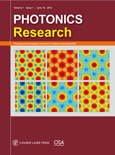
Photonics Research
Transforming Research into Photonic InnovationsPhotonics Research, published by Chinese Laser Press, is a premier international journal that aims to disseminate cutting-edge research and advancements in the field of photonics, encompassing areas such as atomic and molecular physics, optics, and materials science. Since its inception in 2013, this journal has established itself as a vital resource for academics and professionals, reflected in its impressive Q1 rankings in both Atomic and Molecular Physics, and Optics (15/224) and Electronic, Optical and Magnetic Materials (26/284) as per Scopus, underscoring its influence within the scientific community. With substantial contributions to the field, Photonics Research continues to foster innovation and collaboration among researchers, serving as an essential platform for the publication of high-quality studies that push the boundaries of knowledge. The journal operates on an open-access model, ensuring that research is readily available to a global audience, thereby enhancing its accessibility and impact. Whether you are a researcher, student, or professional, engaging with this journal offers a significant opportunity to stay at the forefront of photonic technologies and ideas.
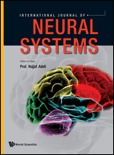
International Journal of Neural Systems
Unveiling Innovations in Neural Systems for a Better TomorrowThe International Journal of Neural Systems, published by World Scientific Publishing Co Pte Ltd, is a prestigious peer-reviewed journal dedicated to the dynamic field of neural systems research. With an ISSN of 0129-0657 and an E-ISSN of 1793-6462, this journal serves as a vital resource for researchers, professionals, and students interested in the intersections of computer science, neural networks, and communications. Noteworthy for its impact, the journal has achieved impressive rankings in 2023, positioned in the Q1 quartile for both Computer Networks and Communications as well as in the miscellaneous category of Medicine, highlighting its interdisciplinary significance and broad relevance. The journal's Scopus rank places it at #33 out of 395 in its category, reflecting its influence and reach within the academic community. While the journal is not open access, its contributions to advancing the understanding of neural systems are invaluable, offering a platform for disseminating cutting-edge research and fostering collaboration among scholars. Since its inception, the International Journal of Neural Systems remains committed to excellence and innovation in its published content, making it an essential subscription for everyone involved in this exciting and rapidly evolving field.
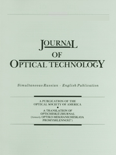
JOURNAL OF OPTICAL TECHNOLOGY
Connecting Ideas in Optical TechnologyJOURNAL OF OPTICAL TECHNOLOGY, published by the Optica Publishing Group, serves as a vital resource for researchers and professionals in the fields of optical technology and related disciplines. Established with a commitment to advancing knowledge, this journal spans a broad spectrum of topics, including applied mathematics, atomic and molecular physics, and various engineering disciplines, with a converged publication period from 1995 to 2024. Although it currently holds a Q4 ranking across multiple categories in 2023, it is an important platform for innovative research ideas in a rapidly evolving field. The absence of Open Access may guide readers to explore alternative access options through institutional subscriptions. The journal’s ISSN is 1070-9762 and its E-ISSN is 1091-0786, ensuring accessibility for a global audience. As a publication aimed at fostering scholarly communication, it invites contributions that highlight emerging trends and novel developments in optical technology, catering to a multifaceted audience of researchers, professionals, and students.

eLight
Connecting Researchers to Transformative Insights in ScienceeLight is a leading academic journal published by SPRINGER NATURE, dedicated to the dynamic field of Atomic and Molecular Physics, as well as Electronic, Optical, and Magnetic Materials. Launched in 2021, the journal has quickly established itself as a reputable source of cutting-edge research, evidenced by its impressive Q1 quartile rankings in both categories for 2023, alongside remarkable Scopus rankings that place it in the top 2% of its fields. With a commitment to advancing knowledge and fostering innovation, eLight invites contributions from researchers, professionals, and students who are passionate about exploring new frontiers in these critical areas of study. Hitting a critical intersection of physics and materials science, the journal provides an open forum for the dissemination of experimental findings, theoretical studies, and application-based research, ensuring accessibility to vital discoveries that drive progress in technology and academia. Located in Singapore, eLight is poised to make significant contributions to the scientific community until at least 2024, and beyond.

NEURAL COMPUTING & APPLICATIONS
Transforming Ideas into Impactful ApplicationsNEURAL COMPUTING & APPLICATIONS is a premier journal dedicated to the burgeoning fields of Artificial Intelligence and Software Engineering, published by Springer London Ltd. Established in 1993, the journal serves as a pivotal platform for disseminating cutting-edge research and innovative applications in neural computing, covering a broad range of topics from algorithm development to real-world applications. With its impressive categorization in the 2023 Journal Quartiles—ranging Q2 in Artificial Intelligence and Q1 in Software—it stands out in its discipline, ranking 42nd out of 407 in Computer Science Software and 50th out of 350 in Computer Science Artificial Intelligence, reflecting its significant impact in the academic community. Although not an open access journal, it provides vital access to significant findings and methodologies that drive advancements in technology. Researchers, professionals, and students looking to stay abreast of the most relevant and impactful developments in these fields will find NEURAL COMPUTING & APPLICATIONS an indispensable resource.
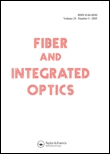
FIBER AND INTEGRATED OPTICS
Connecting Ideas in Integrated Optics and BeyondFIBER AND INTEGRATED OPTICS is a prominent academic journal published by TAYLOR & FRANCIS INC, focusing on the cutting-edge domains of optical and fiber technologies. Since its inception in 1977, the journal has journeyed through expansive developments in the fields of Atomic and Molecular Physics, as well as Electronic, Optical, and Magnetic Materials, boasting a converged publication history extending to 2024. With a solid reputation reflected in its Q3 rankings in both aforementioned categories, FIBER AND INTEGRATED OPTICS serves as an essential platform for researchers, professionals, and students to disseminate and explore innovative findings and methodologies. Although currently not offering Open Access, its scholarly contributions remain invaluable, fostering a deeper understanding and advancements in fiber optic applications and integrated optical systems. Situated in the United Kingdom, the journal continues to attract a diverse global audience, solidifying its significance in contemporary scientific discourse.

Optoelectronics Instrumentation and Data Processing
Pioneering Insights in Instrumentation and Data ProcessingOptoelectronics Instrumentation and Data Processing is a cutting-edge academic journal published by Springer, dedicated to the multidisciplinary field of optoelectronics, providing a platform for researchers, professionals, and students to publish pivotal advancements in instrumentation and data processing techniques related to light-based technologies. Established in 1984, this journal has fostered the sharing of innovative research, facilitating knowledge transfer and collaboration across various scientific domains, particularly in condensed matter physics and electrical engineering. Although it currently holds a Q4 ranking in its respective categories, its open-access policy and commitment to excellence are geared towards elevating research visibility, thus encouraging contribution and dissemination of impactful findings. With a focus on promoting advancements from 2011 to 2024, this journal serves as an invaluable resource for those at the forefront of optoelectronic applications, positioning itself as a significant player within the academic community.
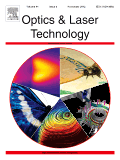
OPTICS AND LASER TECHNOLOGY
Pioneering Insights in Laser ApplicationsOPTICS AND LASER TECHNOLOGY, published by Elsevier Science Ltd, is a premier journal dedicated to advancing knowledge in the fields of optics and laser applications. With its impressive Q1 rankings across three critical categories—Atomic and Molecular Physics, and Optics; Electrical and Electronic Engineering; and Electronic, Optical and Magnetic Materials—the journal stands at the forefront of scientific discourse, boasting a significant impact factor that underscores its relevance. Since its inception in 1970, the journal has consistently provided a platform for the dissemination of cutting-edge research, key innovations, and reviews that influence both academic study and practical applications. Although it currently does not have open access options, its rigorous peer-review process and inclusion in esteemed indexing services make it a valuable resource for researchers, professionals, and students seeking to stay informed about the latest developments in optics and laser technology. The journal’s ongoing commitment to quality research ensures it remains a vital publication for those engaged in this dynamic field, with a converged projection extending through 2025.